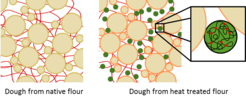Starch/ protein systems
Wheat dough, which is the basis for numerous foods including bread and pasta, is a complex system possessing unique mechanical properties. These result from the special composition of some of the wheat proteins (gliadins and glutenins), which form an elastic network (gluten) upon hydration and kneading. Understanding the underlying mechanisms in the system is a prerequisite for any targeted changes, such as the development of a gluten free product with similar textural properties.

A model system consisting only of starch and gluten in various proportions can be used to study the influence of each individual component as well as their mutual interactions on the rheological properties of the resulting model dough.


Fig. 3: Schematic of the changes occurring after heat treatment of flour highlighting some of the changes that can occur:
- Modification of the starch granule surface leading to changes interactions between granules and between granules and gluten
- Crossslinking of proteins leading to a reduced ability to form network
Heat treatment of flour is of raising importance for the food industry, for the reduction of microorganisms as well as for the targeted modification of functional properties. Using starch/gluten model doughs, starch and gluten can be heat treated separately and the respective effects on the rheological properties of the resulting dough can be quantified.


